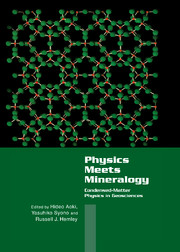Book contents
- Frontmatter
- Contents
- Preface
- List of Contributors
- Part I Introduction
- Part II Advances in Theoretical and Experimental Techniques
- Chapter 2.1 Density Functional Theory in Mineral Physics
- Chapter 2.2 Crystallographic Orbits and Their Application to Structure Types
- Chapter 2.3 Accuracy in X-Ray Diffraction
- Chapter 2.4 Statistical Analysis of Phase-Boundary Observations
- Part III New Findings in Oxides and Silicates
- Part IV Transformations in Silica
- Part V Novel Structures and Materials
- Part VI Melts and Crystal–Melt Interactions
- Subject Index
- Materials Formula Index
- Index of Contributors
Chapter 2.3 - Accuracy in X-Ray Diffraction
Published online by Cambridge University Press: 05 November 2011
- Frontmatter
- Contents
- Preface
- List of Contributors
- Part I Introduction
- Part II Advances in Theoretical and Experimental Techniques
- Chapter 2.1 Density Functional Theory in Mineral Physics
- Chapter 2.2 Crystallographic Orbits and Their Application to Structure Types
- Chapter 2.3 Accuracy in X-Ray Diffraction
- Chapter 2.4 Statistical Analysis of Phase-Boundary Observations
- Part III New Findings in Oxides and Silicates
- Part IV Transformations in Silica
- Part V Novel Structures and Materials
- Part VI Melts and Crystal–Melt Interactions
- Subject Index
- Materials Formula Index
- Index of Contributors
Summary
The career and achievements of Yoshito Matsui have emphasized the attainment of accuracy in experimental studies. To honor him, this contribution presents an analysis of several sources of systematic errors in powder-diffraction experiments and evaluates their effects on the results. In particular, the error arising from uncorrected axial divergence in an energy-dispersive experiment may be as large as 1%. Smaller errors of 0.3% may arise from sample positioning errors, and errors as large as 2% can arise from the effects of nonhydrostatic stress.
Introduction
Although an x-ray diffraction experiment may have very high precision, there are many factors that need to be controlled if an accurate result is to be obtained. This paper discusses the potential systematic errors arising from peak asymmetry that are due to axial divergence, sample positioning errors, and nonhydrostatic stress distributions.
Axial Divergence
Axial divergence, the effect that causes peak asymmetry for diffraction maxima near 0° or 180° 2θ in powder-diffraction patterns, arises from the elliptical shape of the intersection of diffraction cones with the cylinder that describes the opening of the detector as it is swept through 2θ. The description of this effect and a method for calculating the resulting profile have been presented by Finger et al. [1]. This correction can be applied directly for data measured with monochromatic radiation and a diffractometer. Axial divergence should not affect monochromatic powder patterns measured with flat-plate detectors, such as imaging plates or CCD detectors. Such patterns are usually processed to convert the circular rings on the flat two-dimensional detector into a pseudo-one-dimensional pattern by dividing the pattern into a number of wedges and integrating each piece [2].
- Type
- Chapter
- Information
- Physics Meets MineralogyCondensed Matter Physics in the Geosciences, pp. 63 - 70Publisher: Cambridge University PressPrint publication year: 2000



